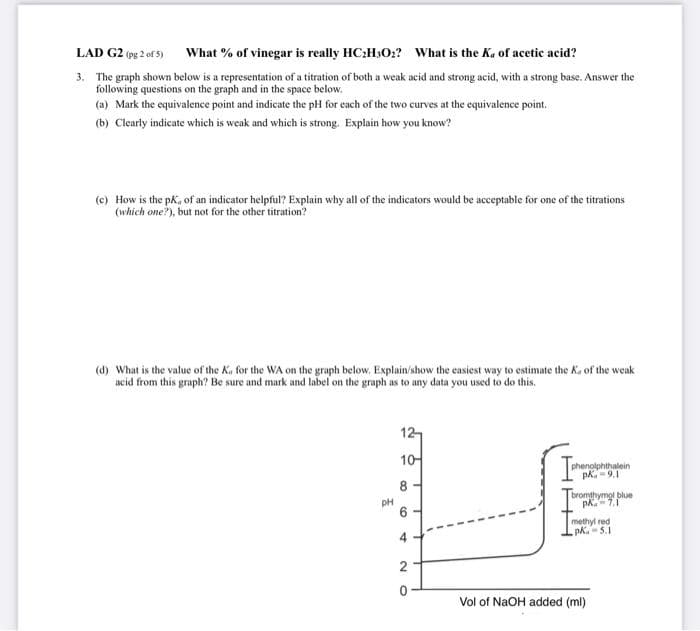LAD G2 (9g 2 of 5) What % of vinegar is really HC:H3O?? What is the K. of acetic acid? 3. The graph shown below is a representation of a titration of both a weak acid and strong acid, with a strong base. Answer the following questions on the graph and in the space below. (a) Mark the oquivalence point and indicate the pH for each of the two curves at the equivalence point. (b) Clearly indicate which is weak and which is strong. Explain how you know?
LAD G2 (9g 2 of 5) What % of vinegar is really HC:H3O?? What is the K. of acetic acid? 3. The graph shown below is a representation of a titration of both a weak acid and strong acid, with a strong base. Answer the following questions on the graph and in the space below. (a) Mark the oquivalence point and indicate the pH for each of the two curves at the equivalence point. (b) Clearly indicate which is weak and which is strong. Explain how you know?
Chapter15: Acid-base Equilibria
Section: Chapter Questions
Problem 5RQ: Draw the general titration curve for a strong acid titrated by a strong base. At the various points...
Related questions
Question
6

Transcribed Image Text:LAD G2 (pg 2 of 5)
What % of vinegar is really HC:H3O:? What is the Ka of acetic acid?
3. The graph shown below is a representation of a titration of both a weak acid and strong acid, with a strong base. Answer the
following questions on the graph and in the space below.
(a) Mark the equivalence point and indicate the pH for each of the two curves at the equivalence point.
(b) Clearly indicate which is weak and which is strong. Explain how you know?
(e) How is the pk, of an indicator helpful? Explain why all of the indicators would be acceptable for one of the titrations
(which one?), but not for the other titration?
(d) What is the value of the K, for the WA on the graph below. Explain/show the casiest way to estimate the Ka of the weak
acid from this graph? Be sure and mark and label on the graph as to any data you used to do this.
12
10-
phenolphthalein
pk.-9.1
8 -
bromthymol blue
PH
methyl red
pk.-5.1
4.
Vol of NaOH added (ml)
6.
Expert Solution
This question has been solved!
Explore an expertly crafted, step-by-step solution for a thorough understanding of key concepts.
This is a popular solution!
Trending now
This is a popular solution!
Step by step
Solved in 4 steps with 3 images

Knowledge Booster
Learn more about
Need a deep-dive on the concept behind this application? Look no further. Learn more about this topic, chemistry and related others by exploring similar questions and additional content below.Recommended textbooks for you


Chemistry
Chemistry
ISBN:
9781305957404
Author:
Steven S. Zumdahl, Susan A. Zumdahl, Donald J. DeCoste
Publisher:
Cengage Learning

Chemistry: An Atoms First Approach
Chemistry
ISBN:
9781305079243
Author:
Steven S. Zumdahl, Susan A. Zumdahl
Publisher:
Cengage Learning


Chemistry
Chemistry
ISBN:
9781305957404
Author:
Steven S. Zumdahl, Susan A. Zumdahl, Donald J. DeCoste
Publisher:
Cengage Learning

Chemistry: An Atoms First Approach
Chemistry
ISBN:
9781305079243
Author:
Steven S. Zumdahl, Susan A. Zumdahl
Publisher:
Cengage Learning

Chemistry: Principles and Reactions
Chemistry
ISBN:
9781305079373
Author:
William L. Masterton, Cecile N. Hurley
Publisher:
Cengage Learning

Chemistry: The Molecular Science
Chemistry
ISBN:
9781285199047
Author:
John W. Moore, Conrad L. Stanitski
Publisher:
Cengage Learning

Chemistry: Principles and Practice
Chemistry
ISBN:
9780534420123
Author:
Daniel L. Reger, Scott R. Goode, David W. Ball, Edward Mercer
Publisher:
Cengage Learning